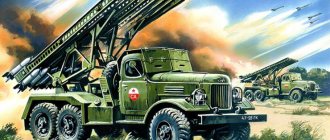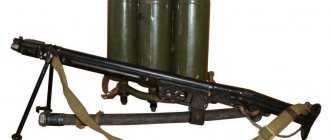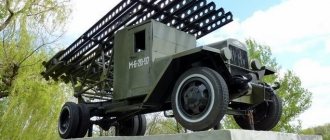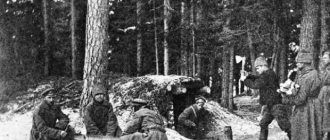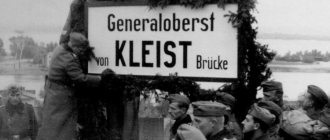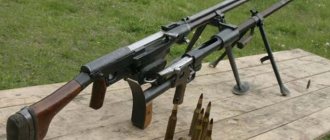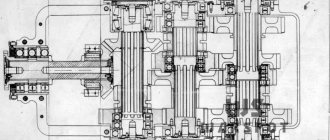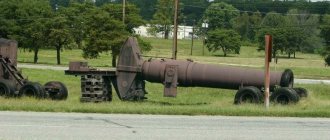The famous fighting vehicle in museums, films and computer games.
On July 14, 1941, not far from the railway station in the city of Orsha, the famous battery of Captain Ivan Flerov attacked the enemy for the first time. The battery was armed with completely new, unknown to the Germans, BM-13 combat vehicles, which the soldiers would affectionately call “Katyushas”.
At that time, few people knew that these vehicles would take part in the most important battles of the Great Patriotic War and, along with the legendary T-34 tanks, would become a symbol of victory in this terrible war. However, both Russian and German soldiers and officers were able to appreciate their power after the first shots.
The story is told by Mikhail Myagkov, professor at the Academy of Military Sciences of the Russian Federation, scientific director of the Russian Military Historical Society .
Everything in the enemy's position was smoking and burning.
At 10 a.m. on July 14, 1941, seven launchers of the first experimental rocket mortar battery under the command of Captain Ivan Flerov struck a concentration of German troops in the center of the Smolensk town of Rudnya.
The effect of the new weapon was unusual for both our own and foreign troops.
A cloud of dust and smoke suddenly rose above the battery, a rumbling grinding sound was heard, and the fiery arrows of the RSs rushed towards the enemy with a roar, leaving behind powerful bright white tails of gas jets, gradually turning orange-red.
A few seconds later, the arrows of the rockets suddenly disappeared, and where the enemy was, everything thundered, and high fountains of explosions shot up. The grass here and there began to smoke and then caught fire.
The order to open fire was given personally by the chief of staff of the artillery of the Western Front, Major General Georgy Cariofilli. The experienced artilleryman was pleased with the results of the shooting.
Acting in the interests of the 20th Army of General Pavel Kurochkin, on July 16, the Flerovites covered the Orsha railway station with a volley, causing a huge fire among the trains and panic in the ranks of the enemy who entered the city. A few hours later, German units crossing in the area of the Orshitsa River were attacked.
The combat performance of the experimental battery was highly praised. On August 4, 1941, in a memo addressed to member of the State Defense Committee Georgy Malenkov, the head of artillery of the Red Army, General Nikolai Voronov, raised the issue of wider use of rocket launchers.
The means are strong. Production should be increased. Continuously form units, regiments and divisions. It is better to apply massively and maintain maximum surprise
- Nikolai Nikolaevich summarized.
"Fathers" of rocket artillery
The formidable weapon, which received the designation BM-13 (combat vehicle with 132-mm shells) in 1941, was the fruit of the efforts of many scientists and designers.
In 1916, the Russian artillery scientist Ivan Grave improved the smokeless gunpowder of the French inventor Paul Viel, proposing his own version - gelatin, or colloidal, gunpowder. On its basis, Ivan Platonovich proposed arming the Russian army with combat missiles, which would be mounted on portable machines with a lifting mechanism. However, the First World War was underway, and the new product, which required considerable time to develop, was not of interest to the Main Artillery Directorate of the Imperial Army.
In Soviet times, one of the creators of domestic jet weapons and a leading ballistics scientist, as a hereditary nobleman, was repeatedly arrested by state security agencies on charges of various counter-revolutionary conspiracies, but, fortunately, without evidence
Grave rose to the rank of major general of the Red Army and received the Stalin Prize of the first degree for his works in 1942.
Based on the type of gunpowder he invented, since the early 20s, researchers from the Gas Dynamics Laboratory Nikolai Tikhomirov and Vladimir Artemyev have been developing RS. The founder of the laboratory, Nikolai Ivanovich Tikhomirov, also proposed his inventions to no avail before the revolution. In particular, jet-powered “self-propelled mines” for firing on land and at sea.
On March 3, 1928, at one of the Leningrad test sites, the first launch of a rocket using smokeless powder was possible. This was a prototype of shells for future Katyushas. After this, the military became interested in developments, which subsequently took place under their auspices.
A number of young and promising researchers from among the artillerymen were sent to help the scientists. Including Ivan Kleimenov, Georgy Langemak, Boris Petrovsky. Civilian specialists also joined the ranks of employees, such as Valentin Glushko, who later became one of the pioneers of Soviet rocket and space technology.
In September 1933, a rocket weapons enthusiast and deputy chairman of the USSR Revolutionary Military Council, Mikhail Tukhachevsky, authorized the creation of a new organization. It was called the Jet Research Institute (since 1937, Scientific Research Institute-3 of the People's Commissariat of Defense Industry).
The crew charges the BM-13 rocket launcher
Photo: waralbum.ru
Military engineer of the first rank Kleimenov was appointed director, and development engineer Sergei Korolev, one of the future founders of Soviet cosmonautics, became his deputy. Sergei Pavlovich was soon replaced in this post by Langemak.
The RNII developed engines and projectiles using solid and liquid fuels, as well as cruise missiles. The work was carried out mainly for aviation - as the most promising area of use of rockets at that time.
At the end of 1937, 82-mm rockets were adopted by the Red Army, and a year later, 132-mm RS. The total weight of the first product was almost seven kilograms with a maximum flight range of 6.2 kilometers, the second - 23 kilograms and 7.1 kilometers.
Museums where you can see the BM-13
Victory Museum
Moscow
The museum is an integral and at the same time the main part of the Victory memorial complex on Poklonnaya Hill in Moscow. On its territory there is an exhibition of weapons, military equipment and engineering structures (Victory weapons, captured equipment, railway troops, military highway, artillery, armored vehicles, air force, navy). Among the museum's exhibits are rare aircraft, one flying one - the U-2, the best tank of the Second World War, the T-34, and, of course, the legendary BM-13 (Katyusha).
Center for military-patriotic education "Museum-Diorama"
Voronezh
The Center for Military Patriotic Education opened in 2000. The museum's collection includes about 2,600 exhibits, including historical relics and replicas on the history of Russia and the Voronezh region. The exhibition space includes four halls and seven exhibitions.
The museum is located at mass grave No. 6. In May 2010, a stele was erected in front of the museum in connection with the awarding of the title “City of Military Glory” to Voronezh. On the square in front of the museum, visitors can see a unique exhibition of military equipment and artillery pieces.
Military Historical Museum of Artillery, Engineering Troops and...
Saint Petersburg
The oldest military museum in Russia. His birthday is considered to be August 29 (new style) 1703.
The museum's exposition is housed in 13 halls on an area of more than 17 thousand square meters. Of particular interest to visitors is the external exhibition of the museum, opened after reconstruction in November 2002. Its main part is located in the courtyard of Kronverk on an area of more than two hectares. About 250 pieces of artillery, missile weapons, engineering equipment and communications equipment are located in open areas, including domestic and foreign weapons - from ancient to the most modern.
Rudnyansky Historical Museum
Rudnyansky district
The Rudnyansky Historical Museum was officially opened on May 9, 1975; today its exhibition occupies four halls. Visitors can see photographs of the first rocket launchers of the legendary BM-13 rocket launcher; photographs and awards of participants in the Battle of Smolensk; personal belongings, awards, photographs of partisans of the Smolensk Partisan Brigade; material about the divisions that liberated the Rudnyansky district in 1943; stands telling the visitor about the damage caused to the area during the Great Patriotic War. Yellowed front-line letters and photographs, newspaper clippings, and personal belongings resurrect before the eyes of museum guests the images of war heroes - soldiers and officers.
Museum of History and Local Lore named after N.Ya. Savchenko
Novosibirsk region
Museum of History and Local Lore named after N.Ya. Savchenko is a center for civic and patriotic education of youth. It consists of two parts: the main building and the demonstration area. It is on the site that all the military and rare equipment available in the museum is located. This is an An-2 plane, a T-34 tank and a steam locomotive.
A worthy place in the exhibitions is occupied by the famous “Katyusha” based on the ZIL-157, the GAZ-AA (one and a half truck), ZIS-5 (three-ton truck), GAZ-67, an armored personnel carrier, the DT-54 tractor, the Universal tractor, a soldier’s field kitchen and etc.
Rockets to help guns and howitzers
Combat use occurred during the local war with Japan on the Khalkhin Gol River. On August 20, 1939, five Soviet fighters under the command of Captain Nikolai Zvonarev, at a signal from the commander, simultaneously fired RS-82 and shot down two enemy aircraft from a distance of a kilometer.
The RS-132 made its debut during the Soviet-Finnish War of 1939-1940. They were equipped with SB front-line bombers, which fired at ground targets. Based on the results of two military campaigns, it was decided that it was much more promising to use rockets not so much in the air as on the ground.
The practical conclusion was supported by theory. The book “Missiles: Their Design and Application,” published in December 1935, edited by Glushko and Langemak, stated that close-range artillery, like long-range artillery, is experiencing a number of difficulties.
The maneuverability of guns is in direct contradiction to the requirement to have a powerful projectile and a high initial speed, since with an increase in the weight of the projectile and speed, the weight of the gun and carriage increases extremely quickly
- stated the authors.
They proposed more actively supplying the Red Army with missiles that do not require conventional guns and can be installed not only on airplanes, but also on ships, cars, tanks, and armored trains. It was emphasized that the lightness and mobility of rocket guns in future wars would make them an indispensable weapon for small infantry rifle units, for which they would form powerful escort artillery.
False fathers of multiple rocket launchers
Before the war, dramatic events occurred in the fate of a number of Katyusha developers. In 1937, Marshal Tukhachevsky and a number of Soviet military leaders were shot on charges of organizing a military conspiracy to seize power. A shadow of suspicion also fell on his research brainchild.
I didn’t have to look for a reason for long. In the same year, the head of the RNII department, Andrei Kostikov, wrote a letter to the People's Commissar of Internal Affairs Nikolai Yezhov. He accused a number of institute employees of sabotage, including Kleimenov, Langemak and Glushko. Kostikov also signaled to other authorities, for example, party authorities, arguing that “methods of work management and our entire system are aimed at reducing the pace of work and at incorrect orientation.”
Purges began at the institute. Among others, Kleymenov, Langemak, Glushko, and Korolev were arrested and subjected to brutal beatings during interrogations. They were required to confess that they were members of an anti-Soviet organization and were engaged in subversive work in the defense industry. After this, Kleimenov and Langemak were shot, and Glushko and Korolev spent the entire war in the so-called “sharashkas” - prison-type design bureaus subordinate to the NKVD of the USSR.
Military engineer first rank Georgy Langemak
Kostikov became the chief engineer of NII-3, developing vigorous activity at his post. On February 19, 1940, he, together with his institute colleague Ivan Gvai and a representative of the Main Artillery Directorate of the Red Army Vasily Aborenkov, received an author's certificate number 3338 stating that he was the developer of a mechanized installation for firing rocket shells of various calibers.
The newly-minted “dad” actively promoted the invention. His efforts were not in vain. On June 17, 1941, a demonstration of the capabilities of the BM-13 to the political and military leadership of the country took place at the Sofrinsky artillery range. Based on the results of the shootings the day before the start of the war, on June 21, Stalin decided to mass produce a new type of weapon. In July 1941, Kostikov was awarded the title of Hero of Socialist Labor, and Gvai and Aborenkov were awarded the Order of Lenin.
In 1942, Kostikov was appointed director of NII-3, and in 1944, Fortune turned its back on him. He was removed from his post and arrested for almost a year on charges of defrauding the government while working on a liquid-propellant rocket engine for aircraft. The project was considered unrealistic and was therefore discontinued.
The investigation also established that neither Kostikov, nor Gvai, nor Aborenkov had anything to do with the development of Katyushas and shells for them. As for the repressed colleagues at the institute, their rehabilitation occurred after Stalin’s death.
Unique combat vehicle "Katyusha"
The history of the appearance and combat use of guards rocket mortars, which became the prototype of all multiple launch rocket systems. Among the legendary weapons that became symbols of our country’s victory in the Great Patriotic War, a special place is occupied by guards rocket mortars, popularly nicknamed “Katyusha”. The characteristic silhouette of a truck from the 40s with an inclined structure instead of a body is the same symbol of perseverance, heroism and courage of Soviet soldiers as, say, the T-34 tank, Il-2 attack aircraft or ZiS-3 cannon.
And here’s what’s especially noteworthy: all these legendary, glorious weapons were designed very shortly or literally on the eve of the war! The T-34 was put into service at the end of December 1939, the first production IL-2s rolled off the production line in February 1941, and the ZiS-3 gun was first presented to the leadership of the USSR and the army a month after the start of hostilities, on July 22, 1941. But the most amazing coincidence happened in the fate of Katyusha. Its demonstration to the party and military authorities took place half a day before the German attack - June 21, 1941... From heaven to earth
In fact, work on the creation of the world's first multiple launch rocket system on a self-propelled chassis began in the USSR in the mid-1930s. An employee of the Tula NPO Splav, which produces modern Russian MLRS, Sergei Gurov, managed to find in the archives agreement No. 251618с dated January 26, 1935 between the Leningrad Jet Research Institute and the Automotive and Armored Directorate of the Red Army, which included a prototype rocket launcher on the BT-5 tank with ten rockets.
A volley of guards mortars. Photo: Anatoly Egorov / RIA Novosti
There is nothing surprising here, since Soviet rocket scientists created the first combat rockets even earlier: official tests took place in the late 20s and early 30s. In 1937, the RS-82 82 mm caliber rocket was adopted for service, and a year later the RS-132 132 mm caliber missile was adopted, both of them in a version for underwing installation on aircraft. A year later, at the end of the summer of 1939, the RS-82s were used for the first time in a combat situation. During the battles at Khalkhin Gol, five I-16s used their “eres” in battle with Japanese fighters, quite surprising the enemy with their new weapons. And a little later, already during the Soviet-Finnish war, six twin-engine SB bombers, already armed with RS-132, attacked Finnish ground positions.
Naturally, the impressive - and they really were impressive, although to a large extent due to the unexpectedness of the use of the new weapon system, and not its ultra-high efficiency - the results of the use of "eres" in aviation forced the Soviet party and military leadership to rush the defense industry to create a ground-based version . Actually, the future “Katyusha” had every chance to make it to the Winter War: the main design work and tests were carried out back in 1938–1939, but the military was not satisfied with the results - they needed a more reliable, mobile and easy-to-handle weapon.
In general terms, what would become part of soldiers’ folklore on both sides of the front as “Katyusha” a year and a half later was ready by the beginning of 1940. In any case, author’s certificate No. 3338 for a “rocket launcher for a sudden, powerful artillery and chemical attack on the enemy using rocket shells” was issued on February 19, 1940, and among the authors were employees of the RNII (since 1938, which bore the “numbered” name Research Institute-3) Andrey Kostikov, Ivan Gvai and Vasily Aborenkov.
This installation was already seriously different from the first samples that entered field testing at the end of 1938. The missile launcher was located along the longitudinal axis of the vehicle and had 16 guides, each of which carried two projectiles. And the shells themselves for this vehicle were different: aircraft RS-132s turned into longer and more powerful ground-based M-13s.
Actually, in this form, a combat vehicle with rockets came out to review new models of weapons of the Red Army, which took place on June 15–17, 1941 at a training ground in Sofrino, near Moscow. Rocket artillery was left as a “snack”: two combat vehicles demonstrated firing on the last day, June 17, using high-explosive fragmentation rockets. The shooting was observed by People's Commissar of Defense Marshal Semyon Timoshenko, Chief of the General Staff Army General Georgy Zhukov, Head of the Main Artillery Directorate Marshal Grigory Kulik and his deputy General Nikolai Voronov, as well as People's Commissar of Armaments Dmitry Ustinov, People's Commissar of Ammunition Pyotr Goremykin and many other military personnel. One can only guess what emotions overwhelmed them as they looked at the wall of fire and the fountains of earth rising on the target field. But it is clear that the demonstration made a strong impression. Four days later, on June 21, 1941, just a few hours before the start of the war, documents were signed on the adoption and urgent deployment of mass production of M-13 rockets and a launcher, officially named BM-13 - “combat vehicle - 13” "(according to the missile index), although sometimes they appeared in documents with the index M-13. This day should be considered the birthday of “Katyusha”, which, it turns out, was born only half a day earlier than the beginning of the Great Patriotic War that glorified her. First hit
The production of new weapons took place at two enterprises at once: the Voronezh plant named after the Comintern and the Moscow one, and the capital plant named after Vladimir Ilyich became the main enterprise for the production of M-13 shells. The first combat-ready unit - a special reactive battery under the command of Captain Ivan Flerov - went to the front on the night of July 1-2, 1941.
Commander of the first Katyusha rocket artillery battery, captain Ivan Andreevich Flerov. Photo: RIA Novosti
But here's what's remarkable. The first documents on the formation of divisions and batteries armed with rocket mortars appeared even before the famous shootings near Moscow! For example, the General Staff directive on the formation of five divisions armed with new equipment was issued a week before the start of the war - June 15, 1941. But reality, as always, made its own adjustments: in fact, the formation of the first units of field rocket artillery began on June 28, 1941. It was from this moment that, as determined by the directive of the commander of the Moscow Military District, three days were allotted for the formation of the first special battery under the command of Captain Flerov.
According to the preliminary staffing schedule, which was determined even before the Sofrino shootings, the rocket artillery battery was supposed to have nine rocket launchers. But the manufacturing plants could not cope with the plan, and Flerov did not have time to receive two of the nine vehicles - he went to the front on the night of July 2 with a battery of seven rocket mortars. But don’t think that just seven ZIS-6s with guides for launching the M-13 went towards the front. According to the list - there was not and could not be an approved staffing table for a special, that is, essentially an experimental battery - the battery included 198 people, 1 passenger car, 44 trucks and 7 special vehicles, 7 BM-13 (for some reason they appeared in the column “210 mm guns”) and one 152 mm howitzer, which served as a sighting gun.
It was with this composition that the Flerov battery went down in history as the first in the Great Patriotic War and the world’s first combat unit of rocket artillery to participate in hostilities. Flerov and his artillerymen fought their first battle, which later became legendary, on July 14, 1941. At 15:15, as follows from archival documents, seven BM-13s from the battery opened fire at the Orsha railway station: it was necessary to destroy the trains with Soviet military equipment and ammunition that had accumulated there, which did not have time to reach the front and got stuck, having fallen into the hands of enemy. In addition, reinforcements for the advancing Wehrmacht units also accumulated in Orsha, so that an extremely attractive opportunity for the command arose to solve several strategic problems at once with one blow.
And so it happened. By personal order of the deputy chief of artillery of the Western Front, General George Cariophylli, the battery launched the first blow. In just a few seconds, the full ammunition load of the battery was fired at the target - 112 rockets, each of which carried a combat charge weighing almost 5 kg - and all hell broke loose at the station. With the second blow, Flerov’s battery destroyed the Nazis’ pontoon crossing across the Orshitsa River - with the same success.
A few days later, two more batteries arrived at the front - Lieutenant Alexander Kun and Lieutenant Nikolai Denisenko. Both batteries launched their first attacks on the enemy in the last days of July in the difficult year of 1941. And from the beginning of August, the Red Army began to form not individual batteries, but entire regiments of rocket artillery.
Guards in the first months of the war The first document on the formation of such a regiment was issued on August 4: a decree of the USSR State Committee for Defense ordered the formation of one guards mortar regiment armed with M-13 launchers. This regiment was named after the People's Commissar of General Mechanical Engineering Pyotr Parshin - the man who, in fact, approached the State Defense Committee with the idea of forming such a regiment. And from the very beginning he offered to give him the rank of Guards - a month and a half before the first Guards Rifle Units appeared in the Red Army, and then all the others.
"Katyusha" on the march. 2nd Baltic Front, January 1945. Photo: Vasily Savransky / RIA Novosti
Four days later, on August 8, the staffing schedule for the Guards rocket launcher regiment was approved: each regiment consisted of three or four divisions, and each division consisted of three batteries of four combat vehicles. The same directive provided for the formation of the first eight regiments of rocket artillery. The ninth was the regiment named after People's Commissar Parshin. It is noteworthy that already on November 26, the People's Commissariat of General Engineering was renamed into the People's Commissariat of Mortar Weapons: the only one in the USSR that dealt with one single type of weapon (existed until February 17, 1946)! Isn't this evidence of the great importance the country's leadership attached to rocket mortars?
Another evidence of this special attitude was the decree of the State Defense Committee, issued a month later - on September 8, 1941. This document actually turned rocket mortar artillery into a special, privileged type of armed forces. Guards mortar units were withdrawn from the Main Artillery Directorate of the Red Army and turned into guards mortar units and formations with their own command. It was directly subordinate to the Headquarters of the Supreme High Command, and included the headquarters, the weapons department of the M-8 and M-13 mortar units and operational groups in the main directions.
The first commander of the guards mortar units and formations was military engineer 1st rank Vasily Aborenkov, a man whose name appeared in the author’s certificate for a “rocket launcher for a sudden, powerful artillery and chemical attack on the enemy using rocket shells.” It was Aborenkov, as first the head of the department and then the deputy head of the Main Artillery Directorate, who did everything to ensure that the Red Army received new, unprecedented weapons.
After this, the process of forming new artillery units went into full swing. The main tactical unit was the regiment of guards mortar units. It consisted of three divisions of M-8 or M-13 rocket launchers, an anti-aircraft division, and service units. In total, the regiment consisted of 1,414 people, 36 BM-13 or BM-8 combat vehicles, and other weapons - 12 37 mm anti-aircraft guns, 9 DShK anti-aircraft machine guns and 18 light machine guns, not counting small arms of personnel. A salvo of one regiment of M-13 rocket launchers consisted of 576 rockets - 16 "eres" in a salvo of each vehicle, and a regiment of M-8 rocket launchers - of 1296 rockets, since one vehicle fired 36 projectiles at once. "Katyusha", "Andryusha" and other members of the jet family
By the end of the Great Patriotic War, the guards mortar units and formations of the Red Army became a formidable striking force that had a significant impact on the course of hostilities. In total, by May 1945, Soviet rocket artillery consisted of 40 separate divisions, 115 regiments, 40 separate brigades and 7 divisions - a total of 519 divisions.
These units were armed with three types of combat vehicles. First of all, these were, of course, the Katyushas themselves - BM-13 combat vehicles with 132-mm rockets. They became the most popular in Soviet rocket artillery during the Great Patriotic War: from July 1941 to December 1944, 6844 such vehicles were produced. Until Studebaker Lend-Lease trucks began to arrive in the USSR, the launchers were mounted on the ZIS-6 chassis, and then American six-axle heavy trucks became the main carriers. In addition, there were modifications to the launchers to accommodate the M-13 on other Lend-Lease trucks.
The 82mm Katyusha BM-8 had much more modifications. Firstly, only these installations, due to their small dimensions and weight, could be mounted on the chassis of light tanks T-40 and T-60. Such self-propelled rocket artillery units were called BM-8-24. Secondly, installations of the same caliber were mounted on railway platforms, armored boats and torpedo boats, and even on railcars. And on the Caucasian front they were converted to fire from the ground, without a self-propelled chassis, which would not have been able to turn around in the mountains. But the main modification was the launcher for M-8 missiles on a vehicle chassis: by the end of 1944, 2,086 of them were produced. These were mainly BM-8-48, launched into production in 1942: these vehicles had 24 beams, on which 48 M-8 rockets were installed, and they were produced on the chassis of the Forme Marmont-Herrington truck. Until a foreign chassis appeared, BM-8-36 units were produced on the basis of the GAZ-AAA truck.
Harbin. Parade of Red Army troops in honor of the victory over Japan. Photo: TASS Photo Chronicle
The latest and most powerful modification of the Katyusha was the BM-31-12 guards mortars. Their story began in 1942, when it was possible to design a new M-30 missile, which was the already familiar M-13 with a new 300 mm caliber warhead. Since they did not change the rocket part of the projectile, the result was a kind of “tadpole” - its resemblance to a boy, apparently, served as the basis for the nickname “Andryusha”. Initially, the new type of projectiles were launched exclusively from a ground position, directly from a frame-like machine on which the projectiles stood in wooden packages. A year later, in 1943, the M-30 was replaced by the M-31 rocket with a heavier warhead. It was for this new ammunition that by April 1944 the BM-31-12 launcher was designed on the chassis of a three-axle Studebaker.
These combat vehicles were distributed among the units of guards mortar units and formations as follows. Of the 40 separate rocket artillery battalions, 38 were armed with BM-13 installations, and only two were armed with BM-8. The same ratio was in the 115 guards mortar regiments: 96 of them were armed with Katyushas in the BM-13 version, and the remaining 19 were armed with 82-mm BM-8. Guards mortar brigades were generally not armed with rocket launchers of a caliber smaller than 310 mm. 27 brigades were armed with frame launchers M-30, and then M-31, and 13 - self-propelled M-31-12 on a vehicle chassis. She who started rocket artillery
During the Great Patriotic War, Soviet rocket artillery had no equal on the other side of the front. Despite the fact that the notorious German Nebelwerfer rocket mortar, nicknamed “Donkey” and “Vanyusha” by Soviet soldiers, had comparable effectiveness to the Katyusha, it was significantly less mobile and had one and a half times shorter firing range. The achievements of the USSR's allies in the anti-Hitler coalition in the field of rocket artillery were even more modest.
It was only in 1943 that the American Army adopted 114-mm M8 rockets, for which three types of launchers were developed. Installations of the T27 type were most reminiscent of the Soviet Katyushas: they were mounted on off-road trucks and consisted of two packages of eight guides each, installed transversely to the longitudinal axis of the vehicle. It is noteworthy that the United States repeated the original design of the Katyusha, which Soviet engineers abandoned: the transverse arrangement of the launchers led to strong rocking of the vehicle at the time of the salvo, which catastrophically reduced the accuracy of fire. There was also a T23 option: the same package of eight guides was installed on the Willis chassis. And the most powerful in terms of salvo force was the T34 installation option: 60 (!) guides that were installed on the hull of the Sherman tank, directly above the turret, which is why guidance in the horizontal plane was carried out by turning the entire tank.
In addition to them, the US Army during World War II also used an improved M16 rocket with a T66 launcher and a T40 launcher on the chassis of medium M4 tanks for 182-mm rockets. And in Great Britain, since 1941, the five-inch 5”UP rocket was in service; for salvo firing of such projectiles, 20-tube ship launchers or 30-tube towed wheeled launchers were used. But all these systems were, in fact, only a semblance of Soviet rocket artillery: they failed to catch up or surpass the Katyusha either in terms of prevalence, or in combat effectiveness, or in scale of production, or in popularity. It is no coincidence that the word “Katyusha” to this day serves as a synonym for the word “rocket artillery”, and the BM-13 itself became the ancestor of all modern multiple launch rocket systems.
They were the first
A separate experimental battery of rocket launchers was created in the first days of the war. At the suggestion of the head of the Military Artillery Academy named after F.E. Dzerzhinsky Leonid Govorov, captain Ivan Flerov, a student of the command faculty, was appointed its commander.
Ivan Andreevich was considered one of the best artillerymen of the Red Army. For his distinctions in breaking through the Mannerheim Line and in the battles near Lake Saunayarvi during the Soviet-Finnish War, he was awarded the Order of the Red Star. The 36-year-old officer energetically began putting together a unit, and on the evening of July 3, 1941, a convoy of 44 trucks stretched from Moscow to the west.
In addition to seven installations, the battery included a 152-mm howitzer, which was used as a sighting weapon. Thirty vehicles carried shells and cartridges, while the cabins and bodies of the rest carried personnel to the front. 170 people had to test what engineers and designers had been working on for years.
The secrecy was the strictest, and outwardly the installations, covered with tarpaulin, resembled anything but a rocket battery. Even the command of the Western Front did not really know what kind of strange unit was heading towards them.
Red Army soldiers service a combat vehicle
Photo: waralbum.ru
The successful debut of the Flerov team paved the way for other experimental batteries. For example, Lieutenant Alexander Kun or Senior Lieutenant Pyotr Degtyarev. On August 3, 1941, the Degtyarevites struck their first blow against the advancing Nazis near Leningrad.
In August, the formation of the first divisions and regiments began, the commanders of which were appointed the best representatives of the cannon artillery units. Formation took place in the camps of the First Moscow Red Banner Artillery School named after L. B. Krasin. The process was led by the head of the school, Colonel Yuri Bazhanov. The importance of what was happening was emphasized by the presence of a commission from the Central Committee of the Party.
The rank and file were recruited mainly from among residents of the capital and the Moscow region.
Each regiment had four divisions armed with 36 BM-13 installations, plus an anti-aircraft division. The personnel numbered more than 1,400 soldiers and commanders. One division could fire 192 RS at once in one salvo, which equated to the simultaneous strike of twelve heavy 152-mm howitzer regiments at once. The rocket regiment simultaneously fired 576 shells. It was a crushing force.
Better a wolf howl than the sound of a Soviet PC
In September 1941, the new units received the name Guards Mortar Units. The word "guard" emphasized their elite, special character, while "mortar" was inaccurate.
By that time, multiple rocket launchers had received the nickname “Katyusha” among the troops. The origin of the name is not exactly known.
According to one version, Flerov’s battery fired at Rudna from a high hill, and the admiring soldiers remembered the popular song of Matvey Blanter to the words of Mikhail Isakovsky: “Katyusha came ashore, on a high bank, on a steep one.”
The last battle of captain Flerov
GMCHs were removed from the subordination of the Main Artillery Directorate of the Red Army, and the post of commander of guards mortar units was established for their leadership. Vasily Aborenkov was appointed to this position as a person related to these weapons. He simultaneously received the status of Deputy People's Commissar of Defense. That is, Stalin himself.
In April 1943, to improve interaction between cannon and rocket artillery, the GMCH was subordinated to Voronov. By that time they already consisted of brigades and divisions.
Ivan Flerov before the Great Patriotic War
Photo:
The fate of a number of the first individual batteries was tragic. In the Vyazemsky cauldron in October 1941, the personnel of Senior Lieutenant Evgeniy Cherkasov and Lieutenant Stepan Shuktomov died. At the same time, two installations, along with ammunition, fell into the hands of the Germans.
Ivan Flerov also laid his head there. His batteries took their last battle on the morning of October 6, 1941, near the village of Bogatyri, Ugransky district, Smolensk region. Ivan Andreevich was buried at the site of his death - in the 60s, when search engines discovered his remains. In 1963, the brave commander was posthumously awarded the Order of the Patriotic War, first degree, and in 1995 he was awarded the title of Hero of the Russian Federation. Of the 170 Flerovites, only 46 came out to their own.
German fog guns against Soviet Katyushas
Having studied the BM-13s that came to them, the Germans remained generally indifferent to them. They had their own Nebelwerfer 41 rocket launchers ("fog thrower"), based on the Pak 35/36 anti-tank gun. Their combat use occurred during the storming of the Brest Fortress in June 1941, at which almost three thousand high-explosive rockets were fired.
Unlike the mobile Katyusha, which was fired directly from a vehicle, German fog guns were transported using a half-track tractor. In the combat position, the installation was uncoupled, the frames were raised, after which the crew fired a salvo.
The image of the BM-13 (“Katyusha”) is actively used in video games about the Second World War:
BM-13 (“Katyusha”) in the computer game Company of Heroes 2
BM-13 salvo in the computer game “Behind Enemy Lines - 2”
Vehicle BM-13 (Katyusha)
A Katyusha salvo in the computer game War Front: Turning Point
Hit infantry and artillery
In the first half of the war, when the enemy was advancing and had an advantage in manpower and equipment in decisive directions, Katyushas were often the only means of thwarting the enemy attack. The commanders of regiments and divisions tried to hit the German columns, as well as the German infantry units preparing to attack. Or according to their reserves.
For example, during the urban battles for Stalingrad, Colonel Erokhin’s regiment was truly a lifesaver for the commander of the 62nd Army, General Vasily Chuikov.
The UZROs worked well against artillery and mortar batteries, but against a dug-in enemy and his tanks, their effectiveness was greatly reduced.
This was due to the peculiarities of the ballistics of the Katyushas, the dispersion ellipse of which was different from that of cannon artillery. When shooting at maximum distances, it sharply stretched out along the front, at close ranges it looked like a narrow strip in depth, and at medium distances it turned into a circle
It was very difficult to conduct direct fire, since the large dispersion of the RSs did not allow them to hit targets closer than 700 meters from the positions of their troops. Because of this, the observation posts of the GMCH were located as close as possible to the front edge in order to accurately know the location of the enemy.
Minuses
Of course, every coin has two sides. "Katyushas" suffered from high dispersion of shells and low shooting accuracy. The effectiveness against armored vehicles and serious fortifications was quite small, as was the firing range. During the march, Katyushas often overturned due to their high center of gravity, and clouds of smoke during firing unmasked the installation.
Hit and quickly change positions
However, anything happened at the front. During the Battle of Moscow on November 11, 1941, the division under the command of Captain Sergei Kirsanov not only supported the attack of its infantry, but also knocked out 17 tanks.
At the end of July 1942, in two days of fighting, the 269th division of the 49th mortar guards regiment destroyed 15 German tanks in the Rostov direction. On August 31, 1943, while repelling a Nazi counterattack in the Donbass direction, soldiers of the 23rd Guards Mortar Regiment under the command of Major Timofey Shankin burned eight enemy armored vehicles.
Katyusha battery on the chassis of an American truck Studebacker US6
Photo: waralbum.ru
Another disadvantage of the Katyushas was that when firing, due to the fire trails of the rocket launchers and smoke at the positions, the enemy could detect the location of batteries and divisions from a great distance. As a rule, bombers or fighters with crosses on their wings immediately took off into the air and attacked the missile launchers’ firing positions. Long-range Nazi artillery often opened fire.
Usually, the MMC units, having fired, immediately left for waiting positions, where they took cover and were replenished with ammunition. It was recommended to fire the next salvo in another place. Because of the German shelling, fighters from other units experienced mixed feelings about their proximity to the Katyushas. On the one hand, they were pleased with the power of the missilemen’s fire. On the other hand, they grumbled that they would leave, and they would have to pay for the unmasking.
Subsequently, during the offensive, the Guards mortarmen chose their firing positions first, and the other branches of the army stayed away from them.
About the nickname
Flerov's first battery took part in the battles for Smolensk, Dukhovshchina, Roslavl, Spas-Demensk. Other batteries, there were about five of them, were located in the area of the city of Rudni. And the first version about the origin of the nickname of these cars - “Katyusha” - is really connected with the song. The batteries fired a volley into Rudny Square, where the Germans were at that moment; one of the witnesses to what was happening allegedly said: “Yes, this is a song!” - and someone else confirmed: “Yes, like Katyusha.” And this nickname first migrated to the headquarters of the 20th Army, where the battery was located, and then spread throughout the country.
The second version about the “Katyusha” is connected with: the letter “K” was placed on the cars. This theory is supported by the fact that the soldiers nicknamed the M-20 howitzer with the letter “M” “Mother”. There are many other assumptions about the origin of the nickname “Katyusha”: someone believes that at the moment of the salvo the cars “sang” drawn out - the song of the same name also has a long chant; someone says that one of the cars had the name of a real woman written on it, and so on. But, by the way, there were other names. When the M-31 installation appeared, someone began to call it “Andryusha,” and the German Nebelwerfer mortar was nicknamed “Vanyusha.”
By the way, one of the names of the BM-13 among German soldiers was the nickname “Stalin’s organ”, because the guiding machines looked like pipes. And the sound itself, when the Katyusha “sang”, also resembled organ music.
BM-13 (Katyusha)
BM-13 (Katyusha)
BM-13 (Katyusha)
Destroy the enemy in the mountains and at sea
The course of the war showed that Katyushas are most effective during a barrage of fire. That is, when artillery of all types creates a continuous curtain of shells in front of its attacking units, which moves forward as the pace of the offensive develops. During a number of operations of the Great Patriotic War, it was the salvo of rocket launchers that served as the general signal for the start of powerful artillery barrage for guns and howitzers.
The autumn thaw of the autumn of 1941 and the early onset of winter showed poor maneuverability and maneuverability of the ZIS-6. Something more reliable was needed. The Katyusha now has a “front-line friend” - the BM-8-24 self-propelled artillery mount. It moved on the chassis of light tanks T-40 and T-60. But there were few of them, and the problem was not solved.
It came to exotic solutions. In November 1941, the State Defense Committee allowed the adoption of horse-drawn launchers with variable wheel-sled travel.
American Lend-Lease trucks helped, on which Katyushas began to be installed in 1942. Primarily on the Studebaker US6.
The prediction of Glushko and Langemak came true - the launchers were mounted not only on cars and tanks, but also on ships. They were used to arm torpedo boats in the Black Sea. The sailors' combat account was opened on September 20, 1942 by the crew of Senior Lieutenant Alexander Kurakin, who sank an enemy ship.
During the battle for the Caucasus in the summer and autumn of 1942, it turned out that ordinary mountain guns were powerless to knock out the rangers from the passes. Then, in a short time, special rocket launchers based on the BM-8 were manufactured in Sochi workshops. They were assembled at the launch site, in the mountains, and weighed 68 kilograms. In 1944, these mountain Katyushas, mounted on a Willys chassis, showed excellent performance in offensive battles in the Carpathians.
Composition of "Katyusha"
- The BM-13 launcher consisted of eight open guide rails connected by tubular spars.
- On each of the rails, two RS-132 missiles were installed in pairs on top and bottom.
- The launcher guides were mounted along the vehicle, which released jacks for stability before firing. When aiming at a target, it was possible to change the elevation angle (up to 45 degrees) and the azimuth of the lifting boom with the guide.
- The salvo was fired from the cab of the car or using a remote control.
- Initially, BM-13 systems were installed on the ZIS-6 truck. But subsequently, for this purpose, the all-wheel drive three-axle American Studebaker US6 (Studebaker), supplied to the USSR under Lend-Lease, and the Soviet ZIS-151 truck (after the war) were most often used for this purpose.

